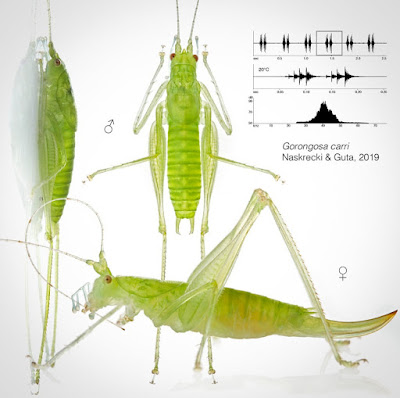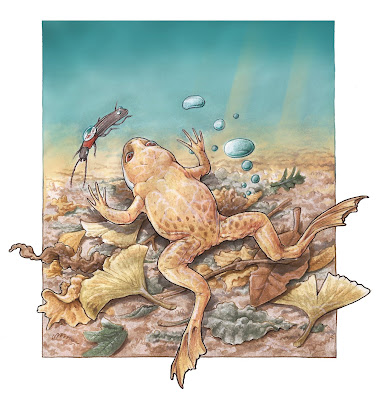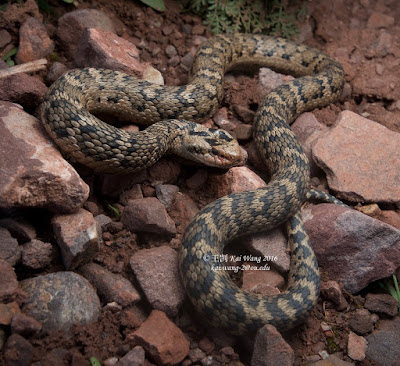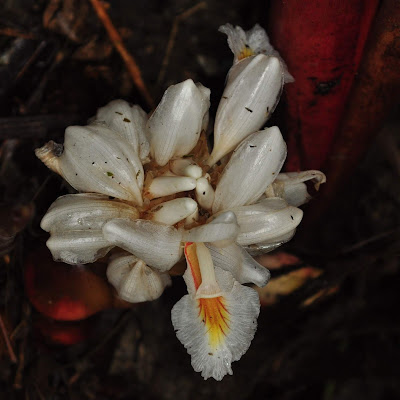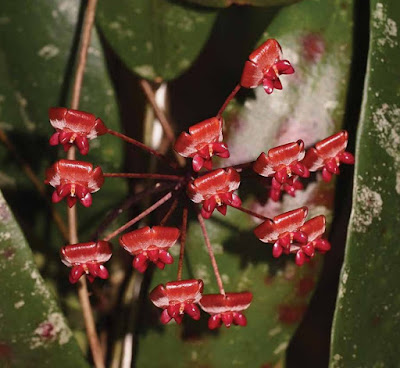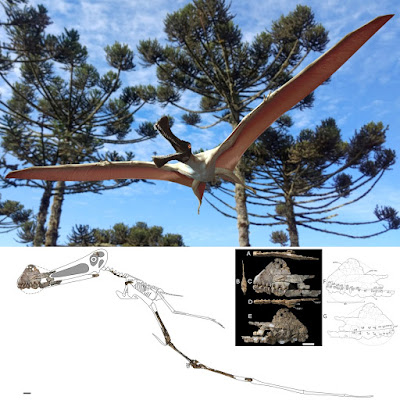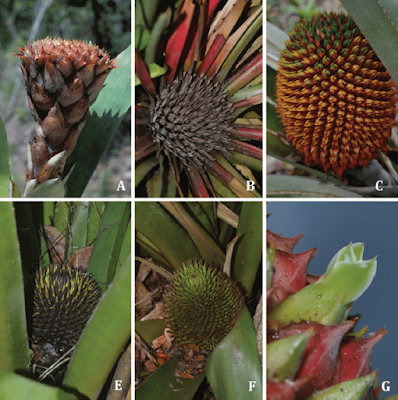[Most Recent Entries] [Calendar View]
Sunday, October 6th, 2019
| Time | Event | ||||
| 1:14p | [Entomology • 2019] Katydids (Orthoptera: Tettigoniidae) of Gorongosa National Park and Central Mozambique
Abstract A list of 60 species of the Tettigoniidae (Orthoptera) recorded from Gorongosa National Park and provinces Sofala and Manica in central Mozambique is provided and their natural history is discussed. Of these, 58 species are illustrated and bioacoustic data are presented for 47 species. Two new genera and 9 new species are described: Gorongosa carri gen. et sp. n., Ovonotus abreuae gen. et sp. n., Afroagraecia muagurai sp. n., Enyaliopsis iaculator sp. n., Eurycorypha parkeri sp. n., Eurycorypha stalmansi sp. n., Eulioptera carolli sp. n., Eulioptera mutembai sp. n., and Parpyrrhicia guytonae sp. n. Four species of Ruspolia are recognized as potentially new and their bioacoustic data are presented. Pseudorhynchus pungens meridionalis Ragge, 1969 is synonymized with Pseudorhynchus pungens pungens (Schaum, 1853); Angustithorax spiniger Massa, 2015 is synonymized with Oxyecous magnus Ragge, 1956; and the synonymy of Lanista africana (Walker, 1870) with Lanista annulicornis (Walker, 1869) is reversed. Two species, G. carri and O. abreuae, appear to be endemic to Mt. Gorongosa and 24 species are recorded for the first time from Mozambique. Keywords: Orthoptera, katydids, new species, new genera, endemism, species list, bioacoustics, Mozambique Piotr Naskrecki and Ricardo Guta. 2019. Katydids (Orthoptera: Tettigoniidae) of Gorongosa National Park and Central Mozambique. Zootaxa. 4682(1); 1-119. DOI: 10.11646/zootaxa.4682.1.1 | ||||
| 1:22p | [Paleontology • 2019] Patagopipa corsolinii • A New Pipoid Frog (Anura, Pipimorpha) from the Paleogene of Patagonia. Paleobiogeographical Implications
Abstract The aim of the present contribution is to describe a new genus and species of Pipoidea from the Huitrera Formation (Eocene) from Patagonia, Argentina. The new genus shows a unique combination of characters indicating that it is a valid taxon different from other pipimorphs, including the coeval Llankibatrachus truebae. The phylogenetic analysis resulted in the nesting of the new taxon within a previously unrecognized endemic clade of South American aglossans. This new clade turns out to be the sister-group of crown-group Pipidae. This phylogenetic proposal reinforces the hypothesis sustaining the dispersal of pipids between Africa and South America through an island chain or a continental bridge across the Atlantic Ocean by Early Tertiary times. Keywords: Panpipidae, South America, Argentina, Paleogene, Island chain Systematic paleontology: Anura Rafinesque, 1815 Pipoidea Fitzinger, 1843 Panpipidae nomen novum. Diagnosis. The anuran clade is diagnosed based on the following synapomorphies: 1) anterior ramus of pterygoid dorsally located with respect to the maxilla (23-1); 2) straight distal margin of sacral diapophyses (99-1); 3) cleithrum covering posterior edge of suprascapular cartilage (114-1); 4) interiliac scar ample both ventrally and dorsally (149-2); and 5) presence of a poorly-developed lateral flange on pterygoid (167-1). Definition. Stem-based clade consisting of Patagopipa and all species that share a more common ancestor with Shelania laurenti, Pipa, and Xenopus laevis than with Vulcanobatrachus mandelai, Avitabatrachus uliana, Cordicephalus gracilis, or Paleobatrachus grandipes. Remarks. The clade Panpipidae is here coined with the aim to include the crown-group Pipidae, Shelaniinae, and another stem pipids. We follow previous authors (Gómez, 2016, Ford and Cannatella, 1993) in the restriction of Pipidae to crown group taxa; this is Pipinae + Xenopodinae. Shelaniinae nomen novum. Diagnosis. This clade is diagnosed based on the following synapomorphies: 1) anterior ramus of pterygoid reaching the antorbital plane (24-1); 2) eight presacral vertebrae (82-1); 3) presacral vertebrae I–II not fused but imbricated medially (88-1); 4) marked forward orientation of the transverse process of presacra vertebrae IV (94-2); 5) cross-section of distal iliac shaft flattened, dorsoventrally compressed (137-2); 6) second pair of ribs anterolaterally oriented (174-1). Definition. The stem-based clade consisting of Patagopipa and all species that share a more common ancestor with Shelania laurenti than with Pipa, Silurana, Xenopus, or Eoxenopoides. Included taxa. Shelania pascuali Casamiquela, 1960; Saltenia ibanezi Reig, 1959; Kuruleufenia xenopoides Gómez, 2016; Patagopipa corsolinii nov. Temporal distribution. From Late Cretaceous to Eocene (probably Pleistocene; Báez et al., 2007) times.
Patagopipa nov. gen. Diagnosis. Small pipoid frog diagnosable based on the following combination of characters (autapomorphies marked by an asterisk): 1) elongate and transversely narrow pterygoids, with poorly expanded proximal flanges*; 2) frontoparietal dorsally flat with rounded anterior and posterior margins; 3) frontoparietal lacking interorbital constriction; and 4) notably robust and stout radioulna and humerus*. Etymology. Patago, from Patagonia the region of Argentina in which the holotype specimen was found; Pipa, the type genus of the Pipidae family. Type species. Patagopipa corsolinii nov. sp. Patagopipa corsolinii nov. sp. Holotype. MLG 2630, a single slab containing a nearly complete skeleton having partially disarticulated skull, incomplete vertebral column, and nearly complete right fore- and hindlimbs. Left forelimb is poorly preserved, and left hindlimb is only represented by the proximal end of the femur. Etymology. The specific epithet honors Rodolfo Corsolini, director of the MLG Museum. Alexis M. Aranciag Rolando, Federico L. Agnolin and Julián Corsolini. 2019. A New Pipoid Frog (Anura, Pipimorpha) from the Paleogene of Patagonia. Paleobiogeographical Implications [Une nouvelle grenouille pipoïde (Anoures, Pipimorpha) du Paléogène de Patagonie. Implications paléobiogéographiques]. Comptes Rendus Palevol. In Press. DOI: 10.1016/j.crpv.2019.04.003 PATAGOPIPA CORSOLINII: UNA NUEVA RANA DE HACE 50 MILLONES DE AÑOS. Résumé: Le but de cet article est de décrire de nouveaux genre et espèce de Pipioidea de la formation Huitrera (Éocène) de Patagonie, Argentine. Le nouveau genre montre une combinaison unique de caractères indiquant que c’est un taxon valide, différent des autres pipimorphes incluant Llankibatrachus truebae, contemporain. L’analyse phylogénétique résulte en la nidification du nouveau taxon au sein d’un clade endémique, auparavant non reconnu, d’aglosses d’Amérique du Sud. Il en résulte que le nouveau clade est le groupe frère du groupe couronne des Pipidae. Cette proposition phylogénétique renforce l’hypothèse en faveur d’une dispersion des pipidés entre l’Afrique et l’Amérique du Sud au moyen d’une chaîne insulaire ou d’un pont continental à travers l’Océan atlantique au Tertiaire inférieur. Mots clés: Panpipidae, Amérique du Sud, Argentine, Paléogène, Chaîne insulaire | ||||
| 1:27p | [Herpetology • 2019] Gloydius huangi • A New Species of Plateau Pit Viper (Serpentes: Viperidae: Gloydius) from the Upper Lancang (=Mekong) Valley in the Hengduan Mountain Region, Tibet, China
Abstract The Plateau Pit Viper, Gloydius strauchi, from southwest and central China has long been considered a single, widespread species despite suspicion that it represents a potential complex of distinct evolutionary lineages. Although series of works were published on the G. strauchi species complex over the last 10 yr, species boundaries and diagnostic features of different members of the complex have remained poorly understood. Combining both morphological and genetic data, we re-evaluate taxonomic statuses of populations of G. strauchi in southwest China and describe the eastern Tibetan populations as a new species. The new species is most closely related to G. monticola phylogenetically, and it differs from all congeners by having a matte dorsal body scale texture, oval and robust head shape, distinct body ornamentation and coloration, and unique hemipene morphology. In addition, we provide the first updated diagnostic key to all recognized members of the G. strauchi species complex, and discuss ongoing taxonomic problems associated with cryptic diversity within the genus in China.
Gloydius huangi sp. nov. Gloydius strauchi Hu et al., 1987: 143. Zhao et al., 1999: 413–419. Zhao, 2006: 127–129. Li et al., 2010: 153–155 Etymology.— The specific name is derived from the surname of Chinese herpetologist Dr. Song Huang from Huangshan University, who has made continuous contributions to research on Chinese snakes in Tibet and the HMR. We suggest ... (Pinyin: Lan Cang Fu) as the Chinese common name of the new species, and Lancang Plateau Viper as its English common name, in the hope of promoting habitat conservation of the Lancang River Basin where the species is native. Kai Wang, Jinlong Ren, Wenjie Dong, Ke Jiang, Jingsong Shi, Cameron D. Siler and Jing Che. 2019. A New Species of Plateau Pit Viper (Reptilia: Serpentes: Gloydius) from the Upper Lancang (=Mekong) Valley in the Hengduan Mountain Region, Tibet, China. J. of Herpetology. 53(3); 224-236. DOI: 10.1670/18-126 | ||||
| 1:52p | [Botany • 2019] Amomum erythranthum & A. ampliflorum • Two New Species and Two New Records for the Flora of Myanmar [Taxonomic Studies on Amomum Roxburgh s.l. (Zingiberaceae) in Myanmar Ⅰ]
Abstract Two taxa of Amomum (Zingiberaceae), Amomum erythranthum and Amomum ampliflorum, from Putao, Kachin State of Northern Myanmar are described and illustrated as new to science. Amomum erythranthum is morphologically similar to A. subulatum and A. nimkeyense in having similar yellow flowers, but can be distinguished by its reddish floral tube, red anther connective, red and pubescent fruit. Amomum ampliflorum is similar to A. maximum, A. dealbatum and A. odontocarpum in white flower, but differs in its longer inflorescence and much larger flower. Two species, Amomum pauciflorum and Wurfbainia microcarpum are recorded for the flora of Myanmar for the first time. Data on ecology, phenology, distribution, conservation status, similarities to the related taxa, as well as colour photographs and line drawings of the type, and voucher specimens are provided for all reported taxa. Keywords: Amomum, Myanmar, Taxonomy, new records, Zingiberaceae, Monocots Amomum erythranthum is morphologically similar to A. subulatum and A. nimkeyense in having similar yellow flowers, but can be distinguished by its reddish floral tube, red anther connective, red and pubescent fruit. Amomum ampliflorum is similar to A. maximum, A. dealbatum and A. odontocarpum in white flower, but differs in its longer inflorescence and much larger flower Hong-Bo Ding, Shi-Shun Zhou, Bin Yang, Ren Li, Mya Bhone Maw, Kyaw Win Maung and Yun-Hong Tan. 2019. Taxonomic Studies on Amomum Roxburgh s.l. (Zingiberaceae) in Myanmar Ⅰ: Two New Species and Two New Records for the Flora of Myanmar. Phytotaxa. 418(2); 158–170. DOI: 10.11646/phytotaxa.418.2.2 Two Ginger Species Reported New to Myanmar | ||||
| 1:53p | [Botany • 2017] Hoya fauziana ssp. angulata (Apocynaceae, Asclepiadoideae) • A New Subspecies from Borneo and Sumatra
Abstract A new Hoya subspecies from Borneo and Sumatra, Hoya fauziana ssp. angulata is described and illustrated. Both subspecies of Hoya fauziana have long lanceolate leaves, pubescent corollas and prominent ovoid corona lobes. They can be separated by the orientation of the pedicels (straight in H. fauziana ssp. fauziana and angled in H. fauziana ssp. angulata) and the type and position of pubescence of the corolla (tube and lobes pubescent with evident sericeous hairs in H. fauziana ssp. fauziana vs only tube finely pubescent in H. fauziana ssp. angulata). Keywords: Asclepiadaceae; Hill Dipterocarp Forest; Indonesia; Kalabakan; Kalimantan; Malaysia; Sabah; Southeast Asia; epiphyte
Hoya fauziana ssp. angulata Rodda, A.L.Lamb, Gokusing & S.Rahayu, subsp. nov. Distinguished from H. fauziana ssp. fauziana by the orientation of the flowers, all facing the same direction (vs perpendicular to the pedicel axis in H. fauziana ssp. fauziana) and by the fine pubescence of the corolla tube (vs long sericeous trichomes on the corolla tube and lobe in H. fauziana ssp. fauziana). Type: L. Gokusing LG56/2017 (holo SAN), Malaysia, Sabah, Tawau, Kalabakan area, Mixed Hill Dipterocarp Forest, 16 May 2017. M. Rodda, A.L. Lamb, L. Gokusing and S. Rahayu. 2017. Hoya fauziana ssp. angulata (Apocynaceae, Asclepiadoideae), A New Subspecies from Borneo and Sumatra. Blumea - Biodiversity, Evolution and Biogeography of Plants. DOI: 10.3767/blumea.2018.63.02.10 | ||||
| 2:22p | [Paleontology • 2019] Ferrodraco lentoni • A New Ornithocheirid Pterosaur from the Winton Formation (Cenomanian–lower Turonian) of Queensland, Australia
Abstract The Australian pterosaur record is poor by world standards, comprising fewer than 20 fragmentary specimens. Herein, we describe the new genus and species Ferrodraco lentoni gen. et sp. nov., based on the most complete pterosaur specimen ever found in Australia, and the first reported from the Winton Formation (Cenomanian–lower Turonian). The presence of premaxillary and mandibular crests, and spike-shaped teeth with subcircular bases, enable Ferrodraco to be referred to Anhangueria. Ferrodraco can be distinguished from all other anhanguerian pterosaurs based on two dental characters: the first premaxillary and mandibular tooth pairs are small; and the fourth–seventh tooth pairs are smaller than the third and eighth ones. Ferrodraco was included in a phylogenetic analysis of Pterosauria and resolved as the sister taxon to Mythunga camara (upper Albian Toolebuc Formation, Australia), with that clade occupying the most derived position within Ornithocheiridae. Ornithocheirus simus (Albian Cambridge Greensand, England), Coloborhynchus clavirostris (Valanginian Hastings Sands, England), and Tropeognathus mesembrinus (upper Aptian–lower Albian Romualdo Formation, Brazil) were resolved as successive sister taxa, which suggests that ornithocheirids were cosmopolitan during the Albian–Cenomanian. Furthermore, the stratigraphic age of Ferrodraco lentoni (Cenomanian–lower Turonian) implies that anhanguerians might have survived later in Australia than elsewhere. Systematic palaeontology Pterosauria Kaup, 1834 Pterodactyloidea Plieninger, 1901 Ornithocheiroidea Seeley, 1891 sensu Kellner, 2003 Anhangueria Rodrigues and Kellner, 2013 Ornithocheirae Seeley, 1870 Ornithocheiridae Seeley, 1870 Ornithocheirinae Andres, Clark and Xu, 2014 Ferrodraco lentoni gen. et sp. nov. Holotype: Australian Age of Dinosaurs Fossil (AODF, Winton, Queensland, Australia) 876 (‘Butch’): anterior portion of skull comprising partial premaxillae, maxillae and dentaries (including premaxillary and mandibular crests and the mandibular symphysis); partial left frontal; left mandibular articular region comprising the surangular, angular and articular; five partial cervical vertebrae; partial right scapulocoracoid; partial left ulna; partial left radius; left proximal and distal carpals; left metacarpal IV; proximal end of right metacarpal IV; fragmentary left non-wing manual phalanges; partial left first wing phalanx (IV-1); and associated fragments. Several elements, including the skull and mandible and many of the appendicular elements (based on key-fits between adherent matrix on anatomically adjacent elements) were clearly articulated post-fossilisation; however, erosion and soil rotation led to fragmentation of the specimen prior to its excavation. Type horizon and locality: Winton Formation (Cenomanian–lower Turonian); Australian Age of Dinosaurs Locality (AODL, Winton, Queensland, Australia) 245 (the ‘Pterosaur Site’), Belmont Station, Winton, Queensland, Australia (Fig. 1). Diagnosis: Anhanguerian pterodactyloid diagnosed by the following autapomorphies: (1) first tooth pair of the premaxilla and mandible smaller than other anterior teeth; (2) fourth up to seventh teeth smaller than third and eighth. Etymology: From the Latin ferrum (iron), in reference to the ironstone preservation of the holotype specimen, and the Latin draco (dragon). The species name honours former Winton Shire mayor Graham Thomas ‘Butch’ Lenton, in recognition of his years of service to the Winton community and support to the Australian Age of Dinosaurs Natural History Museum.
Adele H. Pentland, Stephen F. Poropat, Travis R. Tischler, Trish Sloan, Robert A. Elliott, Harry A. Elliott, Judy A. Elliott and David A. Elliott. 2019. Ferrodraco lentoni gen. et sp. nov., A New Ornithocheirid Pterosaur from the Winton Formation (Cenomanian–lower Turonian) of Queensland, Australia. Scientific Reports. 9: 13454. DOI: 10.1038/s41598-019-49789-4 | ||||
| 2:48p | [Botany • 2019] Karawata gen. nov. • A New Genus of Bromeliaceae Endemic to Brazilian Atlantic Forest
Abstract Phylogenetics work revealed that Aechmea subg. Chevaliera is not a monophyletic group. Seven species previously assigned to the subgenus form a clade with strong statistical support and in sister position to morphologically distinct members of other genera. We present morphological and phylogenetic evidence to segregate these seven species in a new genus named Karawata, which requires the following new combinations: Karawata depressa, Karawata gustavoi, Karawata hostilis, Karawata multiflora, Karawata nigribracteata, Karawata prasinata, and Karawata saxicola. Description of the new genus and its seven species, as well as a key for identification, distribution maps, and illustrations are provided. Karawata J.R. Maciel and G. Sousa, gen. nov. TYPE SPECIES: Karawata multiflora (L.B. Sm.) J.R. Maciel and G. Sousa. Etymology:— The name Karawata refers to the vernacular name used to identify bromeliad plants by local people in Brazil, particularly species of subgenus Chevaliera, from which the Karawata species were segregated. The word is from Tupi (Karawatã or karawatá), a language largely used by native people before the colonization of Brazil. Karawata depressa (L.B. Sm.) J.R. Maciel and G. Sousa, comb. nov. Aechmea depressa L.B. Sm. Arq. Bot. Estado Sao Paulo 3: 54. 1941. Chevaliera depressa L.B. Sm. and Kress. Phytologia 66: 78. 1989. Karawata gustavoi (J.A. Siqueira and Leme) J.R. Maciel and G. Sousa, comb. nov. Aechmea gustavoi J.A. Siqueira and Leme. Selbyana 22: 147(-149; Fig. 2). 2001. Karawata hostilis (E. Pereira) J.R. Maciel and G. Sousa, comb. nov. Aechmea hostilis E. Pereira. Bradea 1: 277. 1972. Chevaliera hostilis (E. Pereira) L.B. Sm. and W.J. Kress. Phytologia 66: 78. 1989. Karawata multiflora (L.B. Sm.) J.R. Maciel and G. Sousa, comb. nov. Aechmea multiflora L.B Sm. Contr. Gray Herb. 117: 4. 1937. Chevaliera multiflora (L.B. Sm.) L.B. Sm. and W.J.Kress. Karawata nigribracteata (J.R. Maciel, Louzada and M. Alves) J.R. Maciel and G. Sousa, comb. nov. Aechmea nigribracteata J.R. Maciel, Louzada and M. Alves. Phytotaxa 188: 233. 2014. Karawata prasinata (G. Sousa and Wanderley) J.R. Maciel and G. Sousa, comb. nov. Aechmea prasinata G. Sousa and Wanderley. Feddes Repert. Spec. Nov. Regni Veg. 125: 39. 2015. Karawata saxicola (L.B. Sm.) J.R. Maciel and G. Sousa, comb. nov. Aechmea saxicola L.B. Sm. Arq. Bot. Estado Sao Paulo 2: 118. 1950. Chevaliera saxicola (L.B.Sm.) L.B.Sm. and W.J.Kress. Phytologia 66: 78. 1989. Jefferson Rodrigues Maciel, Gardene Maria de Sousa, Maria das Graças Lapa Wanderley, Georg Zizka and Marccus Alves. 2019. A New Genus of Bromeliaceae Endemic to Brazilian Atlantic Forest. Systematic Botany. 44(3); 519-535. DOI: 10.1600/036364419X15620113920572 |
| << Previous Day |
2019/10/06 [Calendar] |
Next Day >> |
